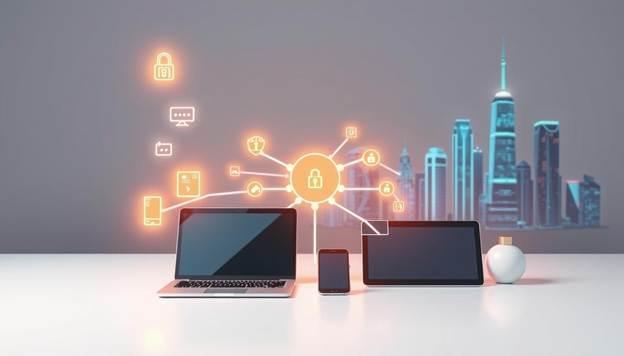Cybersecurity technology Made Simple: How to Stay Safe Online Without the Stress
In the moment’s digital age, staying safe online is a top precedence. With the rise of online pitfalls, it is easy to feel overwhelmed and stressed about guarding your data.
Staying safe online does not have to be complicated. By understanding the basics of cybersecurity technology, you can significantly reduce the threat of falling victim to cyber pitfalls.
Straightforward way, similar as using strong watchwords, being conservative with emails, and keeping your software up to date, can make a significant difference. This composition will guide you through easy cybersecurity tips to help you stay safe online without stress.

crucial Takeaways
Understand the basics of cybersecurity technology to stay safe online.
Apply simple cybersecurity practices to reduce online pitfalls.
Learn how to produce strong watchwords and avoid phishing swindles.
Keep your software and operating system up to date.
Stay informed about the rearmost cybersecurity pitfalls and trends.
The Basics of Cybersecurity Technology Everyone Should Know
In the moment’s connected world, grasping the basics of cybersecurity technology is more important than ever. As we navigate digital geography, understanding the fundamentals can help cover us from colorful online pitfalls.

What Actually Threatens Your Online Safety
Several factors hang out with our online safety, including malware, phishing swindles, and unauthorized access to data. These pitfalls can compromise our digital security, leading to identity theft, fiscal loss, and other profound consequences. Being apprehensive of these pitfalls is the first step in securing our online presence.
Why Cybersecurity Does Not Have to Be Complicated
Cybersecurity does not have to be inviting. By following easy cybersecurity tips, similar as using strong watchwords, keeping software up- to- date, and being conservative with emails and links, we can significantly enhance our online security. It is about taking simple, effective measures to cover ourselves in the digital world.
Simple Security Steps That Make a Big Difference
Guarding your online presence is easier than you suppose. By enforcing many straightforward cybersecurity practices, you can significantly enhance your safety without feeling overwhelmed.
Creating Strong Watchwords Without Losing Your Mind
One of the simplest yet most effective cybersecurity tips is to produce strong, unique watchwords. Use a blend of uppercase and lowercase letters, figures, and special characters. Consider using a word director to keep track of your watchwords.
Use at least twelve characters.
Avoid common patterns and sequences.
Do not exercise watchwords across different accounts.
Streamlining Your bias When and Why It Matters
Keeping your bias streamlined is pivotal for security. Updates frequently include patches for vulnerabilities that hackers could exploit. Enable automatic updates for your operating system, cybersurfed, and other critical software to stay defended.
Spotting Swindles Without Being a Tech Expert
Being conservative with emails and dispatches is crucial to avoiding swindles. Look out for suspicious links, spelling miscalculations, and requests for information. However, it is if an offer seems too good to be true.
“The stylish way to prognosticate the future is to construct it.”- Alan Kay
| Easy Cybersecurity Tip | Benefit |
|---|---|
| Strong Passwords | Prevents unauthorized access |
| Regular Updates | Fixes security vulnerabilities |
| Caution with Emails | Avoids phishing scams |

Easy Cybersecurity Tip Benefit Strong Passwords Prevents unauthorized access Regular Updates Fixes security vulnerabilities Caution with Emails Avoids phishing swindles.
Essential Cybersecurity Technology for Everyday Protection
Cybersecurity technology is no longer just for tech experts; it is for anyone who uses the internet. As we navigate the digital world, having the right cybersecurity measures in place is pivotal for securing our data and online conditioning.
Effective cybersecurity involves a combination of tools, practices, and mindfulness. Let us explore some essential cybersecurity technologies that can significantly enhance your online safety.
Security Tools That Actually Work (Any Are Easy to Use)
There is several cybersecurity tools designed to be stoner-friendly and effective. Some of these include.
Antivirus software that protects against malware and contagions
Firewalls that block unauthorized access to your computer
word directors that help produce and store unique, strong watchwords.
These tools are not only effective but also straightforward to use, making them accessible to everyone.

Guarding Your Smartphone and Personal Data
Smartphones are treasure troves of data, making them high targets for cyber pitfalls. To cover your smartphone, use a combination of a secure cinch screen, two- factor authentication, and be conservative with app warrants. Regularly streamlining your phone’s operating system is also pivotal, as it frequently includes patches for security vulnerabilities.
Securing Your Home Network in Minutes
Securing your home network is simpler than you suppose. Start by changing the dereliction word on your router to a strong, unique bone.
. Enable WPA3 encryption if available, or WPA2 as a minimum. You can also set up a guest network for callers to keep your main network more secure. This way can significantly enhance your home network’s security.
By enforcing these cybersecurity technology measures, you can significantly reduce your threat online and enjoy a safer digital experience.
Conclusion Staying Safe Online Without Tech Stress
Cybersecurity technology does not have to be inviting. By understanding the basics and enforcing easy cybersecurity tips, you can significantly enhance your online safety. Straightforward ways like creating strong watchwords, keeping your bias streamlined, and being conservative of swindles can make a significant difference.
Exercising the right cybersecurity technology is also pivotal. This includes using effective security tools, guarding your smartphone and particular data, and securing your home network. These measures may feel small, but they inclusively contribute to a robust online defense.
By taking this way, you will be well on your way to staying safe online without feeling stressed out about the specialized details. Cybersecurity is about being visionary and informed, not about being a tech expert. Start with these easy cybersecurity tips and enjoy a more secure online experience.
FAQ
What are some easy cybersecurity tips to stay safe online?
Some simple steps include using strong passwords, keeping your devices and software up to date, being cautious with emails and links from unknown sources, and using antivirus software.
How often should I update my passwords?
It’s recommended to update your passwords every 60 to 90 days, especially for sensitive accounts like email and banking. Use a password manager to generate and store unique, complex passwords.
What is two-factor authentication, and how does it help?
Two-factor authentication adds an extra layer of security by requiring not just a password but also a second form of verification, such as a code sent to your phone or a biometric scan. This makes it much harder for attackers to gain unauthorized access.
How can I protect my smartphone from cyber threats?
To protect your smartphone, use a lock screen with a PIN, pattern, or biometric authentication, keep your operating system and apps updated, be cautious with app permissions, and use a reputable antivirus app.
What should I do if I think I’ve been a victim of a cyber scam?
If you suspect you’ve been scammed, immediately change your passwords, notify your bank or relevant institutions, and run a full scan with your antivirus software. Consider reporting the incident to the relevant authorities.
How can I secure my home network?
To secure your home network, change the default password on your router, enable WPA3 encryption, set up a guest network for IoT devices, and regularly update your router’s firmware.





